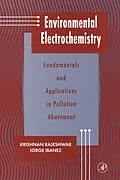The first book of its kind, Environmental Electrochemistry considers the role that electrochemical science and engineering can play in environmental remediation, pollution targeting, and pollutant recycling. Electrochemical-based sensors and abatement technologies for the detection, quantification, and treatment of environmental pollutants are described. Each chapter includes an extensive listing of supplemental readings, with illustrations throughout the bookto clarify principles and approaches detailed in the text. - The first book to review electro- and photoelectrochemical technologies for environmental remediation, pollution sensors and pollutant recycling - Applicable to a broad audience of environmental scientists and practicing electrochemists - Includes both laboratory concepts and practical applications
Autorentext
Krishnan Rajeshwar has published over 120 scientific papers and several book chapters in the fields of thermal analysis methods development, semiconductor electrosynthesis and photoelectrochemistry, and charge transport/storage mechanisms in bioconductive oxides and polymers. Rajeshwar was born in Trivandrum, India in 1947. He received a Ph.D. in Chemistry from the Indian Institute of Science, Bangalore, and completed his post-doctoral training at St. Francis Xavier University in Nova Scotia and Colorado State University in Fort Collins. After finishing his training in 1983, Dr. Rajeshwar joined the Chemistry Department at the University of Texas at Arlington. He was promoted from Assistant Professor to Associate Professor in 1987, and to Full Professor in 1989.
Klappentext
The first book of its kind, Environmental Electrochemistry considers the role that electrochemical science and engineering can play in environmental remediation, pollution targeting, and pollutant recycling. Electrochemical-based sensors and abatement technologies for the detection, quantification, and treatment of environmental pollutants are described. Each chapter includes an extensive listing of supplemental readings, with illustrations throughout the bookto clarify principles and approaches detailed in the text.
- The first book to review electro- and photoelectrochemical technologies for environmental remediation, pollution sensors and pollutant recycling
- Applicable to a broad audience of environmental scientists and practicing electrochemists
- Includes both laboratory concepts and practical applications
Inhalt
Chapter 1: Some Definitions and Classification of Pollutants. Environmental Media and Pollutant Transport. Environmental Chemistry and Toxicology of Common Pollutants--A Primer. Current Methods for Pollutant Analyses. Current Methods for Pollutant Treatment. Electrochemical Technology and the Environment. Summary. Chapter 2: Current, Charge, and Potential. Charge and Mass Transport. Electrode/Electrolyte Interfaces and Electrochemical Cells. Thermodynamics and Kinetics in Electrochemical Systems. Electroanalytical Chemistry. Electrolysis and Electrodeposition. Mass Transport Under Forced Convection in an Electrochemical Cell. Electrochemical Reactor Design. Electrokinetic Phenomena. Semiconductor Electrochemistry. Photoemission at Metal Electrodes. Instrumentation. Chapter 3: Electrochemistry of Inorganic Pollutants. Chapter 4: Flow Injection Analysis. Potentiometric Sensors. Amperometric/Coulometric and Voltammetric/Polargraphic Detection in Flow System. Amperometric Sensors for Environmental Pollutants: Some Examples. Amperometric Gas Sensors. Stripping Analyses: Specialized Aspects. Direct Voltammetric (or Polarographic) Determination of Pollutants. Electrochemistry as an Auxiliary Tool to Atomic Spectroscopies. Conductivity Detectors. Photoassisted Detection of Pollutants. Chapter 5: Positive Features of Electrochemical Remediation. Direct Electrolysis of Pollutants. Indirect Electrolysis of Pollutants. Electroflotation, Electrocoagulation andElectroflocculation. Electrochemical Remediation of Gaseous Pollutants. Membrane-Assisted Processes. Electroremediation of Soils. Emerging Materials for Electrochemical Treatment of Pollutants. Chapter 6: Photolysis of H<->2O<->2 and O<->3and Generation of e<+>-<->aq. Destruction of Organics as Mediated by <+>OH and e<+>-<->aq. Direct Photodissociation of the Pollutant. Reaction Kinetics, Mechanisms, and Examples of Application of the UV/H<->2O<->2 System. Reaction Kinetics, Mechanisms, and Examples of Application of the UV/O<->3 System. The UV/H<->2O<->2/O<->3 Process. UV/H<->2O<->2 and UV/O<->3 Systems: Practical Considerations. Heterogeneous Photocatalysis. Chapter 7: Water Disinfection:Background and Principles. Electrochemical Disinfection of Water. Disinfection by High-Energy Radiation. UV Disinfection. Photoelectrochemical Disinfection of Air and Water. Electrochemical Detection and Enumeration of Microorganisms. Summary. Chapter8: Commercial Vendors of Electrochemical Equipment and Accessories. Electrochemical Sensors of Environmental Pollutants: Commercialization Efforts. Electrochemical Reactors for Pollutant Treatment and Chemical Recycling. Advanced Oxidation Processes: Pilot/Field Tests and Commercialization Efforts. Electrochemical Reactors for Pollutant Treatment and Chemical Recycling. Water Disinfection Technology. Summary. Appendixes. Subject Index.
